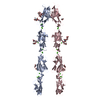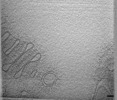[English] 日本語
 Yorodumi
Yorodumi- EMDB-21190: human delta protocadherin 1 full ectodomains on membranes tomogram 3 -
+ Open data
Open data
- Basic information
Basic information
| Entry | Database: EMDB / ID: EMD-21190 | |||||||||||||||||||||
|---|---|---|---|---|---|---|---|---|---|---|---|---|---|---|---|---|---|---|---|---|---|---|
| Title | human delta protocadherin 1 full ectodomains on membranes tomogram 3 | |||||||||||||||||||||
 Map data Map data | human delta protocadherin 1 full ectodomain on membranes tomogram 3 | |||||||||||||||||||||
 Sample Sample |
| |||||||||||||||||||||
| Biological species |  Homo sapiens (human) Homo sapiens (human) | |||||||||||||||||||||
| Method | electron tomography / cryo EM | |||||||||||||||||||||
 Authors Authors | Brasch J / Harrisson OJ / Noble AJ / Carragher B / Potter CS / Shapiro LS | |||||||||||||||||||||
| Funding support |  United States, 6 items United States, 6 items
| |||||||||||||||||||||
 Citation Citation |  Journal: Cell Rep / Year: 2020 Journal: Cell Rep / Year: 2020Title: Family-wide Structural and Biophysical Analysis of Binding Interactions among Non-clustered δ-Protocadherins. Authors: Oliver J Harrison / Julia Brasch / Phinikoula S Katsamba / Goran Ahlsen / Alex J Noble / Hanbin Dan / Rosemary V Sampogna / Clinton S Potter / Bridget Carragher / Barry Honig / Lawrence Shapiro /  Abstract: Non-clustered δ1- and δ2-protocadherins, close relatives of clustered protocadherins, function in cell adhesion and motility and play essential roles in neural patterning. To understand the ...Non-clustered δ1- and δ2-protocadherins, close relatives of clustered protocadherins, function in cell adhesion and motility and play essential roles in neural patterning. To understand the molecular interactions underlying these functions, we used solution biophysics to characterize binding of δ1- and δ2-protocadherins, determined crystal structures of ectodomain complexes from each family, and assessed ectodomain assembly in reconstituted intermembrane junctions by cryoelectron tomography (cryo-ET). Homophilic trans (cell-cell) interactions were preferred for all δ-protocadherins, with additional weaker heterophilic interactions observed exclusively within each subfamily. As expected, δ1- and δ2-protocadherin trans dimers formed through antiparallel EC1-EC4 interfaces, like clustered protocadherins. However, no ectodomain-mediated cis (same-cell) interactions were detectable in solution; consistent with this, cryo-ET of reconstituted junctions revealed dense assemblies lacking the characteristic order observed for clustered protocadherins. Our results define non-clustered protocadherin binding properties and their structural basis, providing a foundation for interpreting their functional roles in neural patterning. | |||||||||||||||||||||
| History |
|
- Structure visualization
Structure visualization
| Movie |
 Movie viewer Movie viewer |
|---|---|
| Supplemental images |
- Downloads & links
Downloads & links
-EMDB archive
| Map data |  emd_21190.map.gz emd_21190.map.gz | 1.7 GB |  EMDB map data format EMDB map data format | |
|---|---|---|---|---|
| Header (meta data) |  emd-21190-v30.xml emd-21190-v30.xml emd-21190.xml emd-21190.xml | 16 KB 16 KB | Display Display |  EMDB header EMDB header |
| Images |  emd_21190.png emd_21190.png | 168.3 KB | ||
| Archive directory |  http://ftp.pdbj.org/pub/emdb/structures/EMD-21190 http://ftp.pdbj.org/pub/emdb/structures/EMD-21190 ftp://ftp.pdbj.org/pub/emdb/structures/EMD-21190 ftp://ftp.pdbj.org/pub/emdb/structures/EMD-21190 | HTTPS FTP |
-Validation report
| Summary document |  emd_21190_validation.pdf.gz emd_21190_validation.pdf.gz | 78.5 KB | Display |  EMDB validaton report EMDB validaton report |
|---|---|---|---|---|
| Full document |  emd_21190_full_validation.pdf.gz emd_21190_full_validation.pdf.gz | 77.6 KB | Display | |
| Data in XML |  emd_21190_validation.xml.gz emd_21190_validation.xml.gz | 499 B | Display | |
| Arichive directory |  https://ftp.pdbj.org/pub/emdb/validation_reports/EMD-21190 https://ftp.pdbj.org/pub/emdb/validation_reports/EMD-21190 ftp://ftp.pdbj.org/pub/emdb/validation_reports/EMD-21190 ftp://ftp.pdbj.org/pub/emdb/validation_reports/EMD-21190 | HTTPS FTP |
-Related structure data
| Related structure data |  6vfpC  6vfqC  6vfrC  6vftC  6vfuC  6vfvC  6vfwC  6vg1C  6vg4C C: citing same article ( |
|---|---|
| EM raw data |  EMPIAR-10369 (Title: Human delta protocadherin 1 full ectodomains on membranes, tomogram 3 EMPIAR-10369 (Title: Human delta protocadherin 1 full ectodomains on membranes, tomogram 3Data size: 106.5 Data #1: Appion-Protomo tilt-series alignments [tilt series] Data #2: K2 tilt-series frames [micrographs - multiframe]) |
- Links
Links
| EMDB pages |  EMDB (EBI/PDBe) / EMDB (EBI/PDBe) /  EMDataResource EMDataResource |
|---|
- Map
Map
| File |  Download / File: emd_21190.map.gz / Format: CCP4 / Size: 1.9 GB / Type: IMAGE STORED AS FLOATING POINT NUMBER (4 BYTES) Download / File: emd_21190.map.gz / Format: CCP4 / Size: 1.9 GB / Type: IMAGE STORED AS FLOATING POINT NUMBER (4 BYTES) | ||||||||||||||||||||||||||||||||||||||||||||||||||||||||||||||||||||
|---|---|---|---|---|---|---|---|---|---|---|---|---|---|---|---|---|---|---|---|---|---|---|---|---|---|---|---|---|---|---|---|---|---|---|---|---|---|---|---|---|---|---|---|---|---|---|---|---|---|---|---|---|---|---|---|---|---|---|---|---|---|---|---|---|---|---|---|---|---|
| Annotation | human delta protocadherin 1 full ectodomain on membranes tomogram 3 | ||||||||||||||||||||||||||||||||||||||||||||||||||||||||||||||||||||
| Projections & slices | Image control
Images are generated by Spider. generated in cubic-lattice coordinate | ||||||||||||||||||||||||||||||||||||||||||||||||||||||||||||||||||||
| Voxel size | X=Y=Z: 7.34344 Å | ||||||||||||||||||||||||||||||||||||||||||||||||||||||||||||||||||||
| Density |
| ||||||||||||||||||||||||||||||||||||||||||||||||||||||||||||||||||||
| Symmetry | Space group: 1 | ||||||||||||||||||||||||||||||||||||||||||||||||||||||||||||||||||||
| Details | EMDB XML:
CCP4 map header:
| ||||||||||||||||||||||||||||||||||||||||||||||||||||||||||||||||||||
-Supplemental data
- Sample components
Sample components
-Entire : trans dimers of protocadherin 1 extracellular domains formed betw...
| Entire | Name: trans dimers of protocadherin 1 extracellular domains formed between membranes of liposomes |
|---|---|
| Components |
|
-Supramolecule #1: trans dimers of protocadherin 1 extracellular domains formed betw...
| Supramolecule | Name: trans dimers of protocadherin 1 extracellular domains formed between membranes of liposomes type: complex / ID: 1 / Parent: 0 / Macromolecule list: all Details: purified full ectodomains of protocadherin 1 are tethered to Ni-NTA lipid head groups presented on the liposome surface through binding of C-terminal hexa-histidine tags |
|---|---|
| Source (natural) | Organism:  Homo sapiens (human) Homo sapiens (human) |
-Supramolecule #2: human delta protocadherin 1
| Supramolecule | Name: human delta protocadherin 1 / type: complex / ID: 2 / Parent: 1 / Macromolecule list: all Details: full ectodomain of human delta protocadherin 1 with a C-termin hexa histidine tag |
|---|
-Supramolecule #3: liposomes
| Supramolecule | Name: liposomes / type: complex / ID: 3 / Parent: 1 Details: liposomes composed of DOPC and DOGS-NTA (8:2 ratio) with 100nm diameter |
|---|
-Macromolecule #1: human protocadherin 1
| Macromolecule | Name: human protocadherin 1 / type: protein_or_peptide / ID: 1 / Enantiomer: LEVO |
|---|---|
| Source (natural) | Organism:  Homo sapiens (human) Homo sapiens (human) |
| Recombinant expression | Organism:  Homo sapiens (human) Homo sapiens (human) |
| Sequence | String: TRVVYKVPEE QPPNTLIGSL AADYGFPDVG HLYKLEVGAP YLRVDGKTGD IFTTETSIDR EGLRECQNQ LPGDPCILEF EVSITDLVQN GSPRLLEGQI EVQDINDNTP NFASPVITLA I PENTNIGS LFPIPLASDR DAGPNGVASY ELQAGPEAQE LFGLQVAEDQ ...String: TRVVYKVPEE QPPNTLIGSL AADYGFPDVG HLYKLEVGAP YLRVDGKTGD IFTTETSIDR EGLRECQNQ LPGDPCILEF EVSITDLVQN GSPRLLEGQI EVQDINDNTP NFASPVITLA I PENTNIGS LFPIPLASDR DAGPNGVASY ELQAGPEAQE LFGLQVAEDQ EEKQPQLIVM GN LDRERWD SYDLTIKVQD GGSPPRASSA LLRVTVLDTN DNAPKFERPS YEAELSENSP IGH SVIQVK ANDSDQGANA EIEYTFHQAP EVVRRLLRLD RNTGLITVQG PVDREDLSTL RFSV LAKDR GTNPKSARAQ VVVTVKDMND NAPTIEIRGI GLVTHQDGMA NISEDVAEET AVALV QVSD RDEGENAAVT CVVAGDVPFQ LRQASETGSD SKKKYFLQTT TPLDYEKVKD YTIEIV AVD SGNPPLSSTN SLKVQVVDVN DNAPVFTQSV TEVAFPENNK PGEVIAEITA SDADSGS NA ELVYSLEPEP AAKGLFTISP ETGEIQVKTS LDREQRESYE LKVVAADRGS PSLQGTAT V LVNVLDCNDN DPKFMLSGYN FSVMENMPAL SPVGMVTVID GDKGENAQVQ LSVEQDNGD FVIQNGTGTI LSSLSFDREQ QSTYTFQLKA VDGGVPPRSA YVGVTINVLD ENDNAPYITA PSNTSHKLL TPQTRLGETV SQVAAEDFDS GVNAELIYSI AGGNPYGLFQ IGSHSGAITL E KEIERRHH GLHRLVVKVS DRGKPPRYGT ALVHLYVNET LANRTLLETL LGHSLDTPLD ID IAGDPEY ERSKQRGNHH HHHH |
-Experimental details
-Structure determination
| Method | cryo EM |
|---|---|
 Processing Processing | electron tomography |
| Aggregation state | 3D array |
- Sample preparation
Sample preparation
| Concentration | 0.7 mg/mL | |||||||||||||||
|---|---|---|---|---|---|---|---|---|---|---|---|---|---|---|---|---|
| Buffer | pH: 7.4 Component:
| |||||||||||||||
| Grid | Support film - Material: CARBON / Support film - topology: LACEY / Details: unspecified | |||||||||||||||
| Vitrification | Cryogen name: ETHANE / Chamber humidity: 65 % / Chamber temperature: 298.15 K / Instrument: GATAN CRYOPLUNGE 3 / Details: 2.5 second blot before plunging.. | |||||||||||||||
| Details | aggregated liposomes were deposited onto EM grids. | |||||||||||||||
| Sectioning | Other: NO SECTIONING |
- Electron microscopy
Electron microscopy
| Microscope | FEI TITAN KRIOS |
|---|---|
| Specialist optics | Spherical aberration corrector: Cs corrector (CEOS GmbH) / Energy filter - Name: GIF Bioquantum / Energy filter - Slit width: 20 eV |
| Image recording | Film or detector model: GATAN K2 QUANTUM (4k x 4k) / Detector mode: COUNTING / Number grids imaged: 1 / Number real images: 46 / Average electron dose: 2.83 e/Å2 |
| Electron beam | Acceleration voltage: 300 kV / Electron source:  FIELD EMISSION GUN FIELD EMISSION GUN |
| Electron optics | Illumination mode: FLOOD BEAM / Imaging mode: BRIGHT FIELD / Cs: 0.001 mm |
| Sample stage | Specimen holder model: FEI TITAN KRIOS AUTOGRID HOLDER / Cooling holder cryogen: NITROGEN |
| Experimental equipment |  Model: Titan Krios / Image courtesy: FEI Company |
- Image processing
Image processing
| Final reconstruction | Algorithm: SIMULTANEOUS ITERATIVE (SIRT) / Software - Name: TOMO3D / Software - details: part of Appion-protomo 2.4.1 / Number images used: 43 |
|---|
 Movie
Movie Controller
Controller








 Z (Sec.)
Z (Sec.) Y (Row.)
Y (Row.) X (Col.)
X (Col.)

















